Cell Phone Policy Proposal
VerifiedAdded on 2023/06/12
|7
|1581
|460
AI Summary
This report discusses the crash risks which increases dramatically, when a driver uses a cell phone while driving. It also provides recommendations for policy makers and future research.
Contribute Materials
Your contribution can guide someone’s learning journey. Share your
documents today.
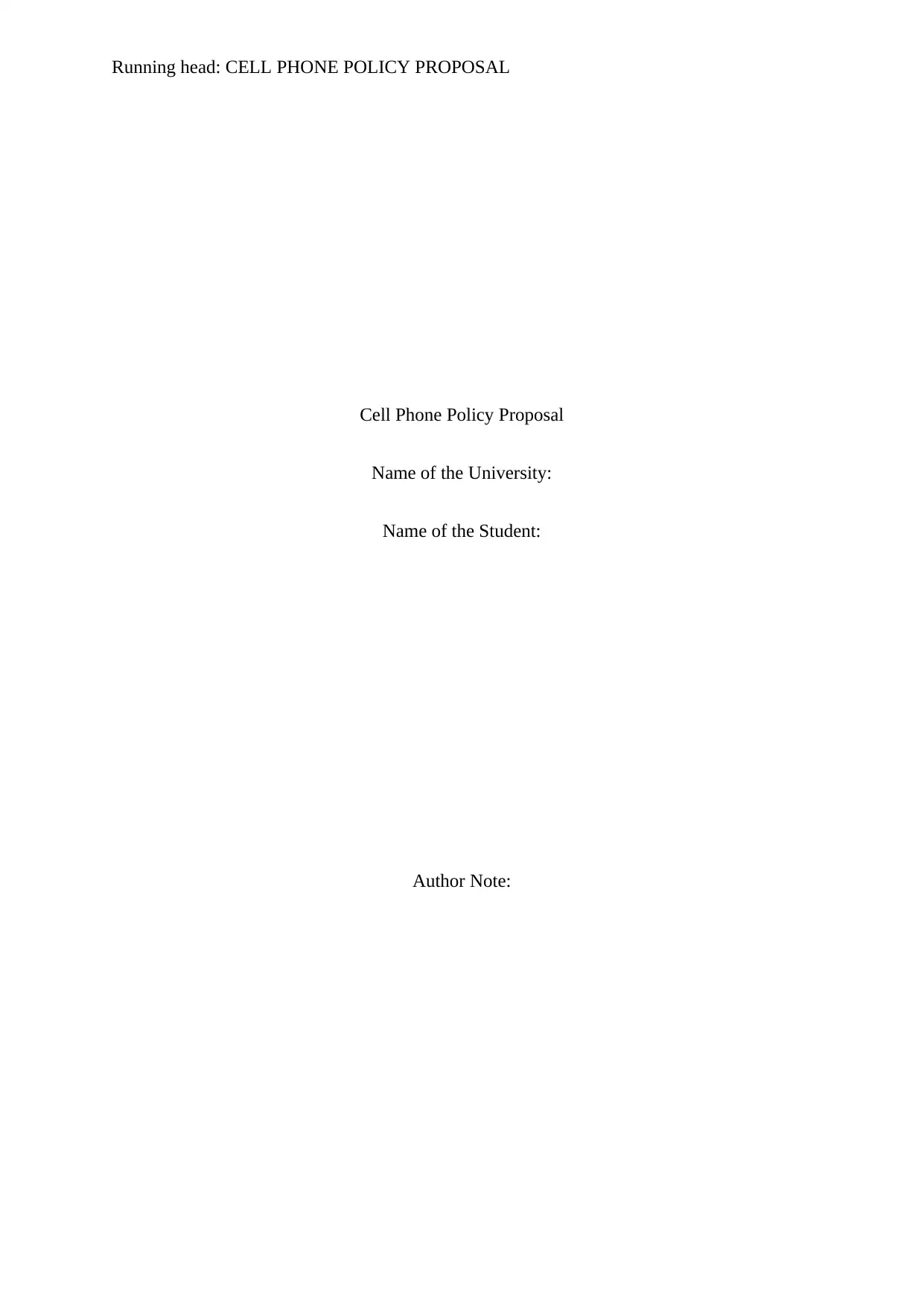
Running head: CELL PHONE POLICY PROPOSAL
Cell Phone Policy Proposal
Name of the University:
Name of the Student:
Author Note:
Cell Phone Policy Proposal
Name of the University:
Name of the Student:
Author Note:
Secure Best Marks with AI Grader
Need help grading? Try our AI Grader for instant feedback on your assignments.
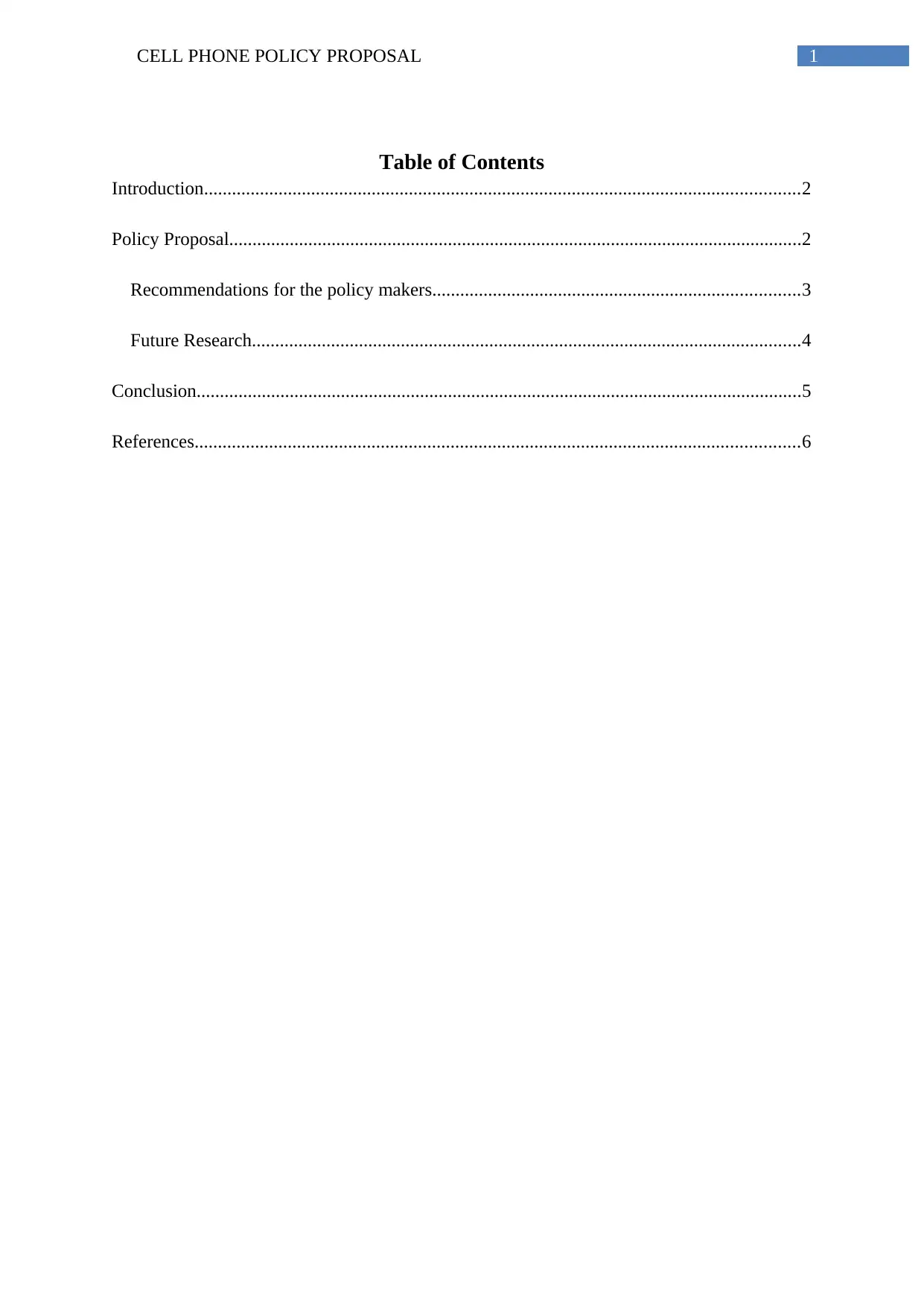
1CELL PHONE POLICY PROPOSAL
Table of Contents
Introduction................................................................................................................................2
Policy Proposal...........................................................................................................................2
Recommendations for the policy makers...............................................................................3
Future Research......................................................................................................................4
Conclusion..................................................................................................................................5
References..................................................................................................................................6
Table of Contents
Introduction................................................................................................................................2
Policy Proposal...........................................................................................................................2
Recommendations for the policy makers...............................................................................3
Future Research......................................................................................................................4
Conclusion..................................................................................................................................5
References..................................................................................................................................6
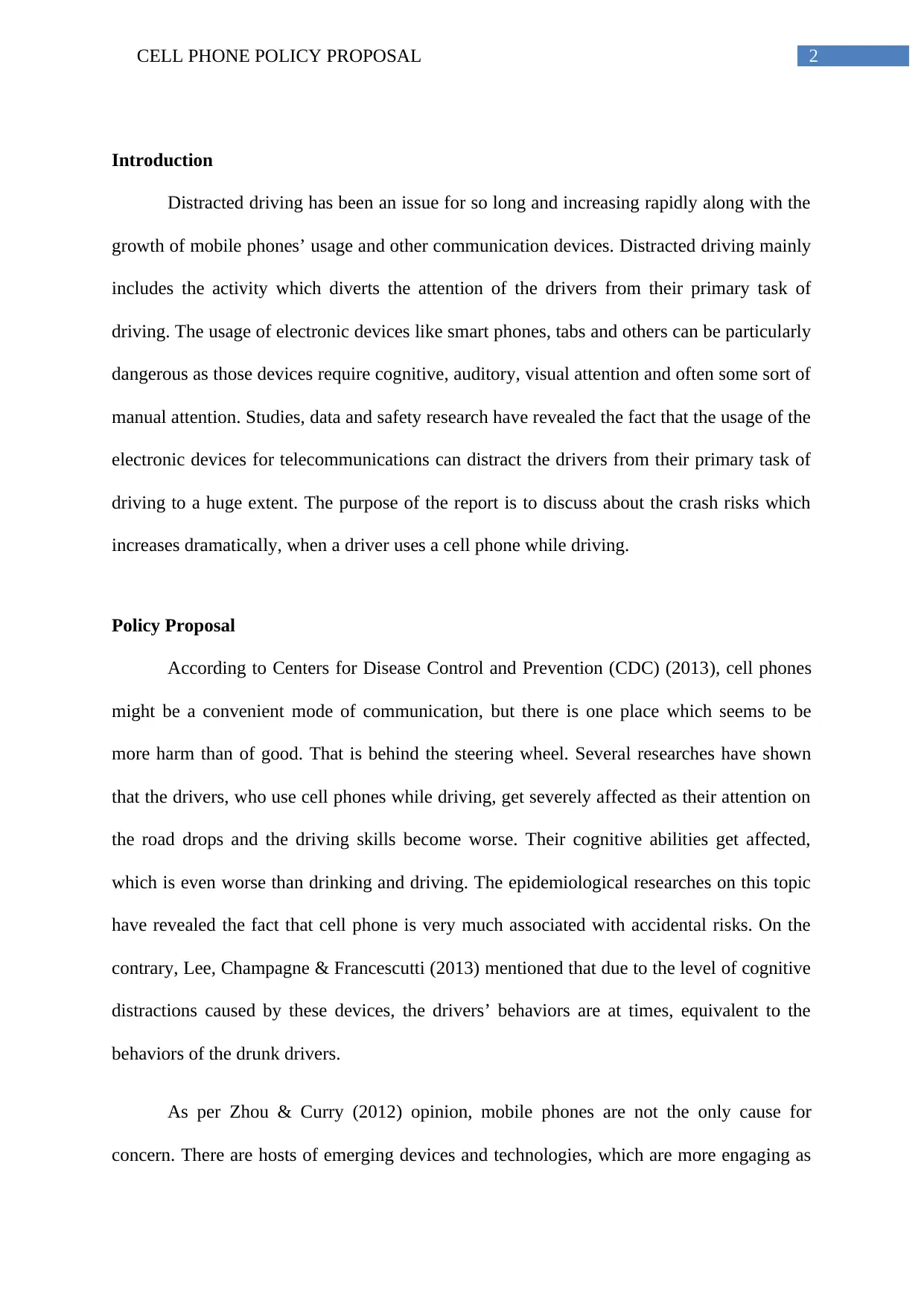
2CELL PHONE POLICY PROPOSAL
Introduction
Distracted driving has been an issue for so long and increasing rapidly along with the
growth of mobile phones’ usage and other communication devices. Distracted driving mainly
includes the activity which diverts the attention of the drivers from their primary task of
driving. The usage of electronic devices like smart phones, tabs and others can be particularly
dangerous as those devices require cognitive, auditory, visual attention and often some sort of
manual attention. Studies, data and safety research have revealed the fact that the usage of the
electronic devices for telecommunications can distract the drivers from their primary task of
driving to a huge extent. The purpose of the report is to discuss about the crash risks which
increases dramatically, when a driver uses a cell phone while driving.
Policy Proposal
According to Centers for Disease Control and Prevention (CDC) (2013), cell phones
might be a convenient mode of communication, but there is one place which seems to be
more harm than of good. That is behind the steering wheel. Several researches have shown
that the drivers, who use cell phones while driving, get severely affected as their attention on
the road drops and the driving skills become worse. Their cognitive abilities get affected,
which is even worse than drinking and driving. The epidemiological researches on this topic
have revealed the fact that cell phone is very much associated with accidental risks. On the
contrary, Lee, Champagne & Francescutti (2013) mentioned that due to the level of cognitive
distractions caused by these devices, the drivers’ behaviors are at times, equivalent to the
behaviors of the drunk drivers.
As per Zhou & Curry (2012) opinion, mobile phones are not the only cause for
concern. There are hosts of emerging devices and technologies, which are more engaging as
Introduction
Distracted driving has been an issue for so long and increasing rapidly along with the
growth of mobile phones’ usage and other communication devices. Distracted driving mainly
includes the activity which diverts the attention of the drivers from their primary task of
driving. The usage of electronic devices like smart phones, tabs and others can be particularly
dangerous as those devices require cognitive, auditory, visual attention and often some sort of
manual attention. Studies, data and safety research have revealed the fact that the usage of the
electronic devices for telecommunications can distract the drivers from their primary task of
driving to a huge extent. The purpose of the report is to discuss about the crash risks which
increases dramatically, when a driver uses a cell phone while driving.
Policy Proposal
According to Centers for Disease Control and Prevention (CDC) (2013), cell phones
might be a convenient mode of communication, but there is one place which seems to be
more harm than of good. That is behind the steering wheel. Several researches have shown
that the drivers, who use cell phones while driving, get severely affected as their attention on
the road drops and the driving skills become worse. Their cognitive abilities get affected,
which is even worse than drinking and driving. The epidemiological researches on this topic
have revealed the fact that cell phone is very much associated with accidental risks. On the
contrary, Lee, Champagne & Francescutti (2013) mentioned that due to the level of cognitive
distractions caused by these devices, the drivers’ behaviors are at times, equivalent to the
behaviors of the drunk drivers.
As per Zhou & Curry (2012) opinion, mobile phones are not the only cause for
concern. There are hosts of emerging devices and technologies, which are more engaging as
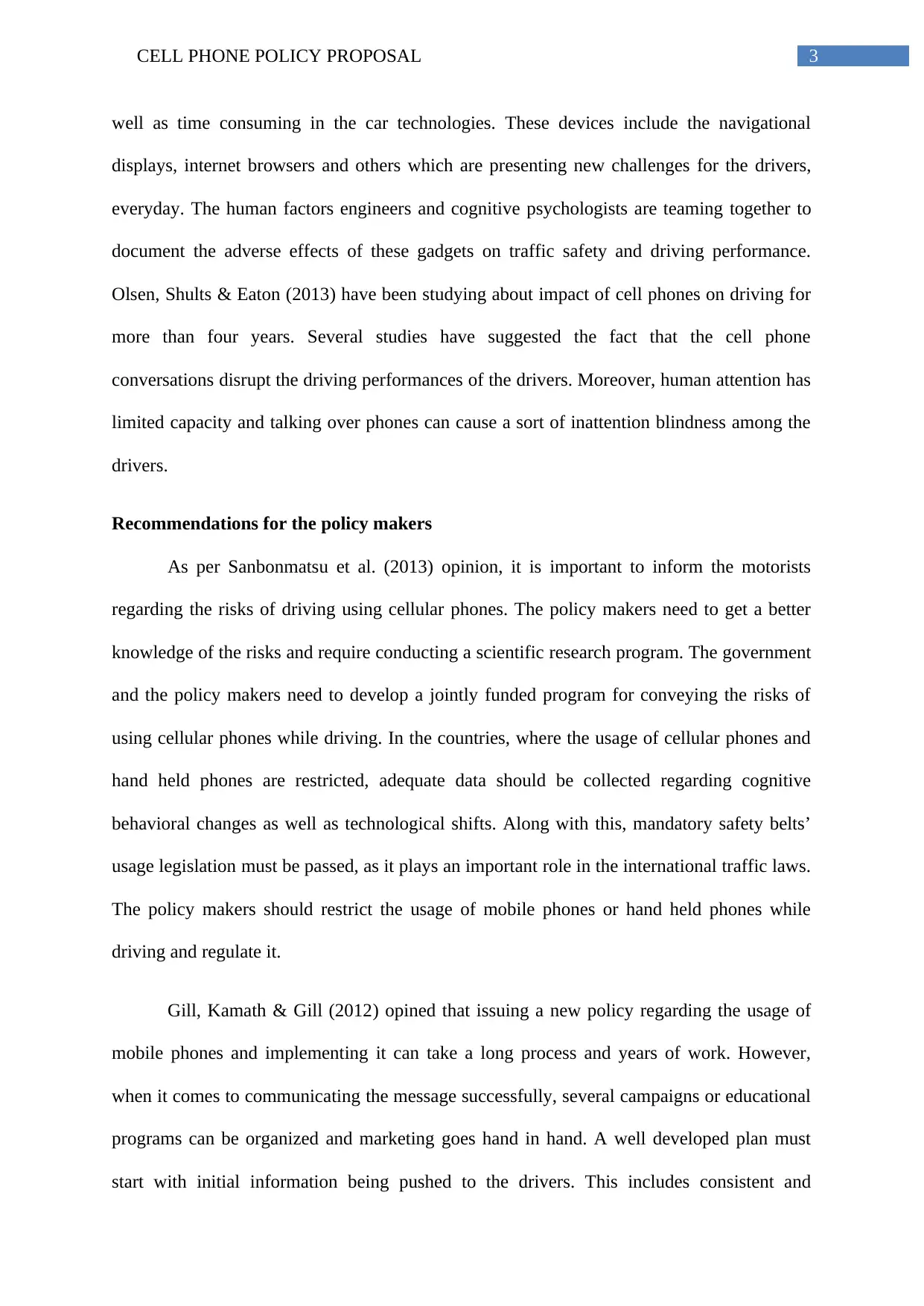
3CELL PHONE POLICY PROPOSAL
well as time consuming in the car technologies. These devices include the navigational
displays, internet browsers and others which are presenting new challenges for the drivers,
everyday. The human factors engineers and cognitive psychologists are teaming together to
document the adverse effects of these gadgets on traffic safety and driving performance.
Olsen, Shults & Eaton (2013) have been studying about impact of cell phones on driving for
more than four years. Several studies have suggested the fact that the cell phone
conversations disrupt the driving performances of the drivers. Moreover, human attention has
limited capacity and talking over phones can cause a sort of inattention blindness among the
drivers.
Recommendations for the policy makers
As per Sanbonmatsu et al. (2013) opinion, it is important to inform the motorists
regarding the risks of driving using cellular phones. The policy makers need to get a better
knowledge of the risks and require conducting a scientific research program. The government
and the policy makers need to develop a jointly funded program for conveying the risks of
using cellular phones while driving. In the countries, where the usage of cellular phones and
hand held phones are restricted, adequate data should be collected regarding cognitive
behavioral changes as well as technological shifts. Along with this, mandatory safety belts’
usage legislation must be passed, as it plays an important role in the international traffic laws.
The policy makers should restrict the usage of mobile phones or hand held phones while
driving and regulate it.
Gill, Kamath & Gill (2012) opined that issuing a new policy regarding the usage of
mobile phones and implementing it can take a long process and years of work. However,
when it comes to communicating the message successfully, several campaigns or educational
programs can be organized and marketing goes hand in hand. A well developed plan must
start with initial information being pushed to the drivers. This includes consistent and
well as time consuming in the car technologies. These devices include the navigational
displays, internet browsers and others which are presenting new challenges for the drivers,
everyday. The human factors engineers and cognitive psychologists are teaming together to
document the adverse effects of these gadgets on traffic safety and driving performance.
Olsen, Shults & Eaton (2013) have been studying about impact of cell phones on driving for
more than four years. Several studies have suggested the fact that the cell phone
conversations disrupt the driving performances of the drivers. Moreover, human attention has
limited capacity and talking over phones can cause a sort of inattention blindness among the
drivers.
Recommendations for the policy makers
As per Sanbonmatsu et al. (2013) opinion, it is important to inform the motorists
regarding the risks of driving using cellular phones. The policy makers need to get a better
knowledge of the risks and require conducting a scientific research program. The government
and the policy makers need to develop a jointly funded program for conveying the risks of
using cellular phones while driving. In the countries, where the usage of cellular phones and
hand held phones are restricted, adequate data should be collected regarding cognitive
behavioral changes as well as technological shifts. Along with this, mandatory safety belts’
usage legislation must be passed, as it plays an important role in the international traffic laws.
The policy makers should restrict the usage of mobile phones or hand held phones while
driving and regulate it.
Gill, Kamath & Gill (2012) opined that issuing a new policy regarding the usage of
mobile phones and implementing it can take a long process and years of work. However,
when it comes to communicating the message successfully, several campaigns or educational
programs can be organized and marketing goes hand in hand. A well developed plan must
start with initial information being pushed to the drivers. This includes consistent and
Secure Best Marks with AI Grader
Need help grading? Try our AI Grader for instant feedback on your assignments.
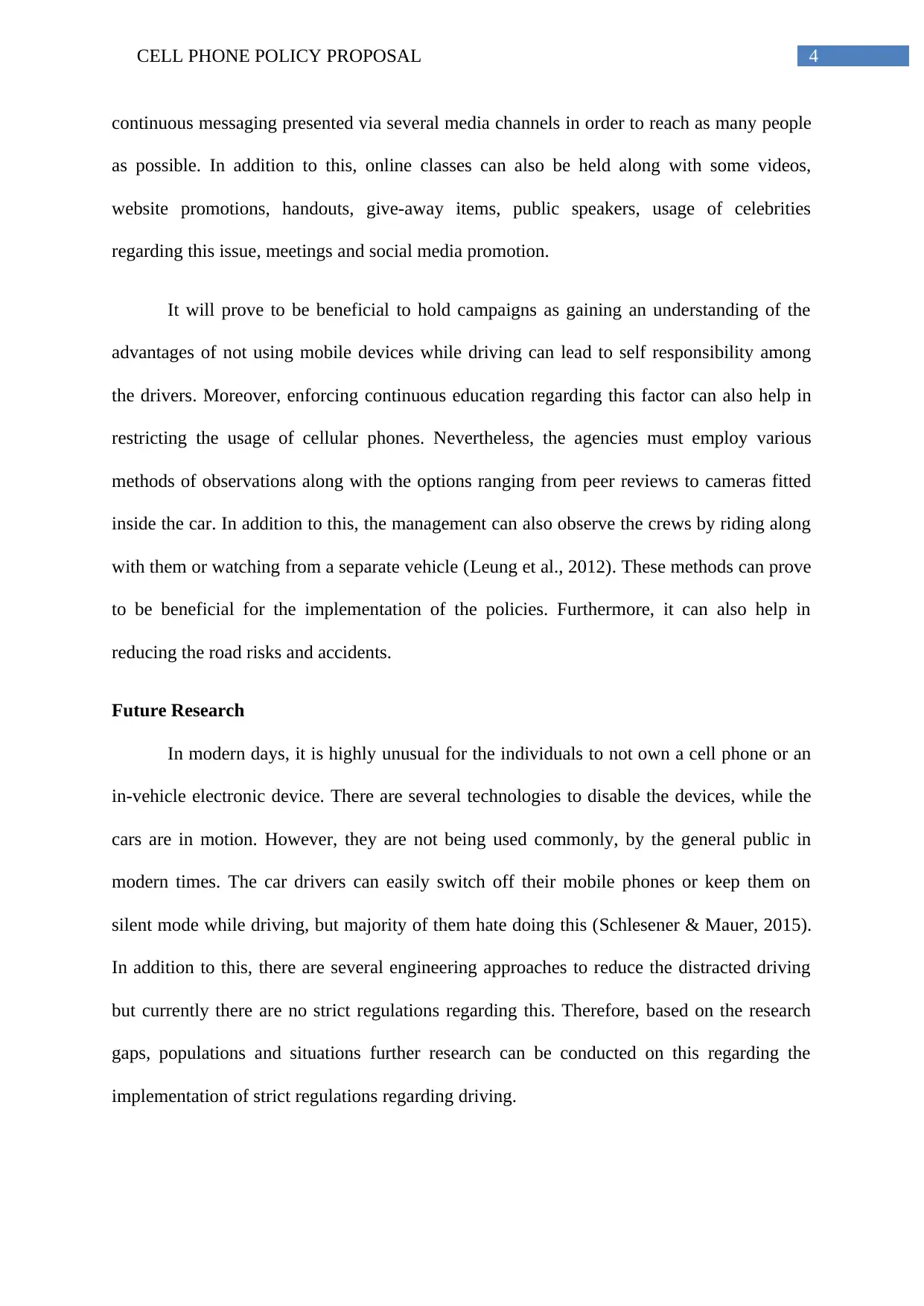
4CELL PHONE POLICY PROPOSAL
continuous messaging presented via several media channels in order to reach as many people
as possible. In addition to this, online classes can also be held along with some videos,
website promotions, handouts, give-away items, public speakers, usage of celebrities
regarding this issue, meetings and social media promotion.
It will prove to be beneficial to hold campaigns as gaining an understanding of the
advantages of not using mobile devices while driving can lead to self responsibility among
the drivers. Moreover, enforcing continuous education regarding this factor can also help in
restricting the usage of cellular phones. Nevertheless, the agencies must employ various
methods of observations along with the options ranging from peer reviews to cameras fitted
inside the car. In addition to this, the management can also observe the crews by riding along
with them or watching from a separate vehicle (Leung et al., 2012). These methods can prove
to be beneficial for the implementation of the policies. Furthermore, it can also help in
reducing the road risks and accidents.
Future Research
In modern days, it is highly unusual for the individuals to not own a cell phone or an
in-vehicle electronic device. There are several technologies to disable the devices, while the
cars are in motion. However, they are not being used commonly, by the general public in
modern times. The car drivers can easily switch off their mobile phones or keep them on
silent mode while driving, but majority of them hate doing this (Schlesener & Mauer, 2015).
In addition to this, there are several engineering approaches to reduce the distracted driving
but currently there are no strict regulations regarding this. Therefore, based on the research
gaps, populations and situations further research can be conducted on this regarding the
implementation of strict regulations regarding driving.
continuous messaging presented via several media channels in order to reach as many people
as possible. In addition to this, online classes can also be held along with some videos,
website promotions, handouts, give-away items, public speakers, usage of celebrities
regarding this issue, meetings and social media promotion.
It will prove to be beneficial to hold campaigns as gaining an understanding of the
advantages of not using mobile devices while driving can lead to self responsibility among
the drivers. Moreover, enforcing continuous education regarding this factor can also help in
restricting the usage of cellular phones. Nevertheless, the agencies must employ various
methods of observations along with the options ranging from peer reviews to cameras fitted
inside the car. In addition to this, the management can also observe the crews by riding along
with them or watching from a separate vehicle (Leung et al., 2012). These methods can prove
to be beneficial for the implementation of the policies. Furthermore, it can also help in
reducing the road risks and accidents.
Future Research
In modern days, it is highly unusual for the individuals to not own a cell phone or an
in-vehicle electronic device. There are several technologies to disable the devices, while the
cars are in motion. However, they are not being used commonly, by the general public in
modern times. The car drivers can easily switch off their mobile phones or keep them on
silent mode while driving, but majority of them hate doing this (Schlesener & Mauer, 2015).
In addition to this, there are several engineering approaches to reduce the distracted driving
but currently there are no strict regulations regarding this. Therefore, based on the research
gaps, populations and situations further research can be conducted on this regarding the
implementation of strict regulations regarding driving.
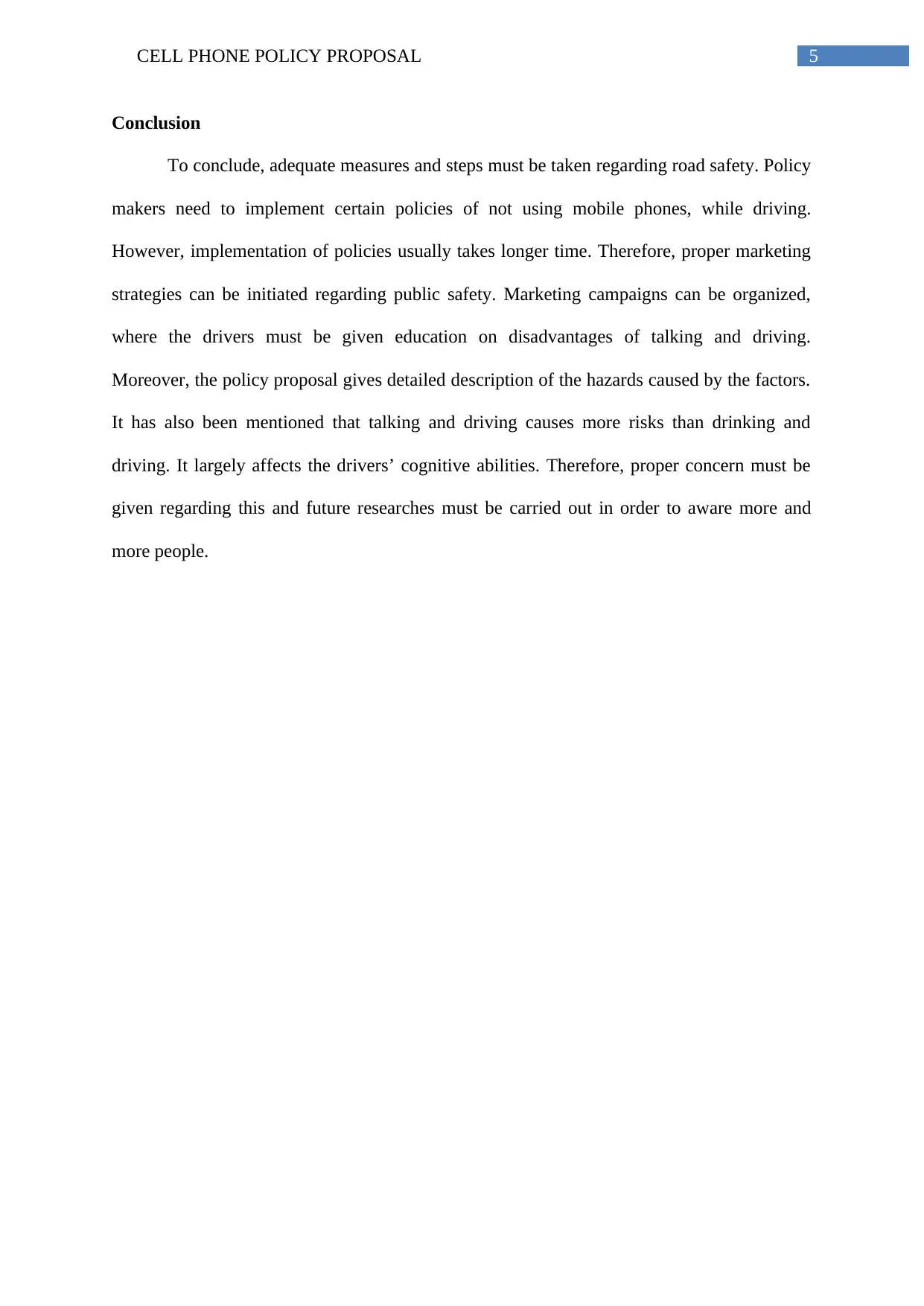
5CELL PHONE POLICY PROPOSAL
Conclusion
To conclude, adequate measures and steps must be taken regarding road safety. Policy
makers need to implement certain policies of not using mobile phones, while driving.
However, implementation of policies usually takes longer time. Therefore, proper marketing
strategies can be initiated regarding public safety. Marketing campaigns can be organized,
where the drivers must be given education on disadvantages of talking and driving.
Moreover, the policy proposal gives detailed description of the hazards caused by the factors.
It has also been mentioned that talking and driving causes more risks than drinking and
driving. It largely affects the drivers’ cognitive abilities. Therefore, proper concern must be
given regarding this and future researches must be carried out in order to aware more and
more people.
Conclusion
To conclude, adequate measures and steps must be taken regarding road safety. Policy
makers need to implement certain policies of not using mobile phones, while driving.
However, implementation of policies usually takes longer time. Therefore, proper marketing
strategies can be initiated regarding public safety. Marketing campaigns can be organized,
where the drivers must be given education on disadvantages of talking and driving.
Moreover, the policy proposal gives detailed description of the hazards caused by the factors.
It has also been mentioned that talking and driving causes more risks than drinking and
driving. It largely affects the drivers’ cognitive abilities. Therefore, proper concern must be
given regarding this and future researches must be carried out in order to aware more and
more people.
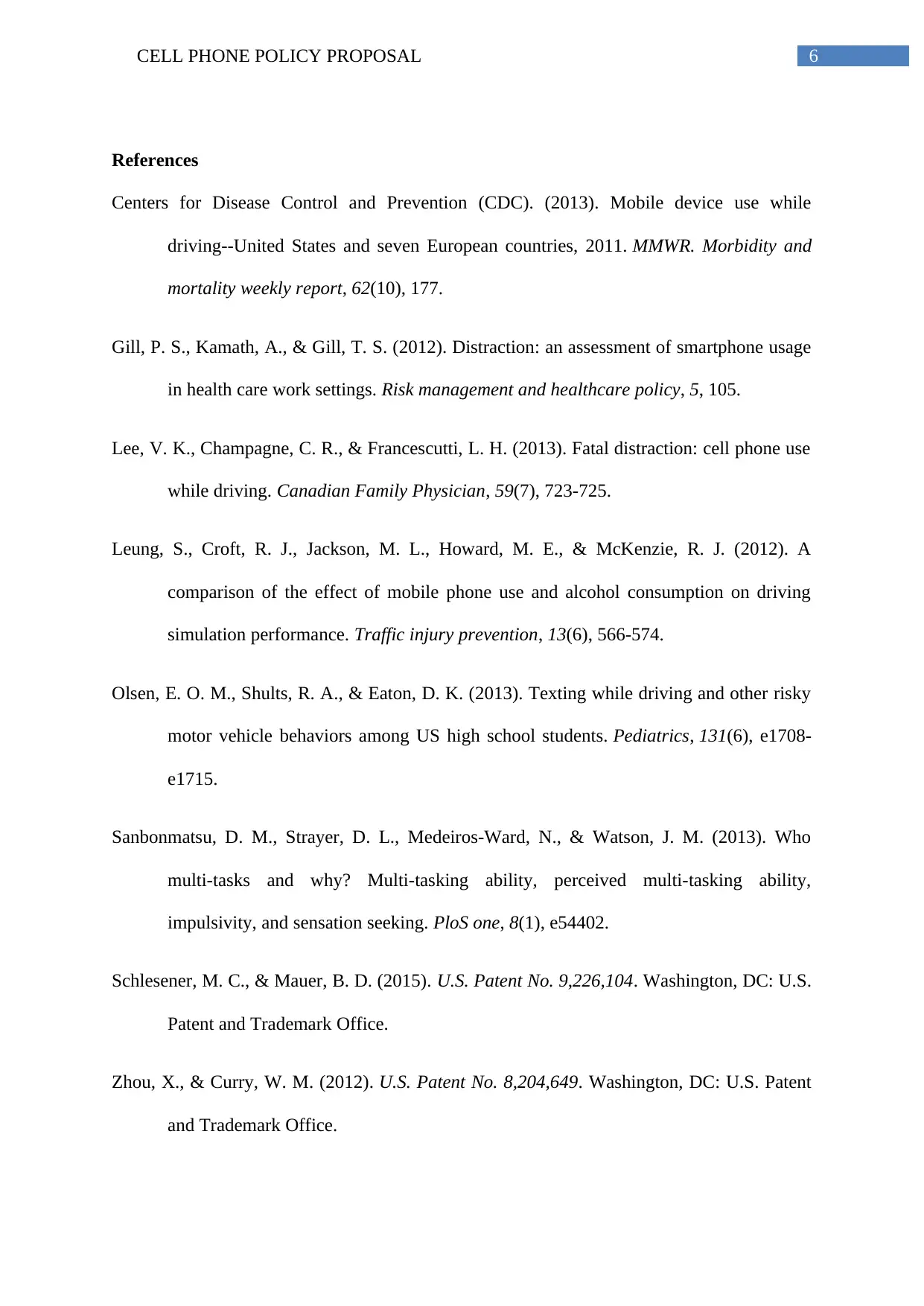
6CELL PHONE POLICY PROPOSAL
References
Centers for Disease Control and Prevention (CDC). (2013). Mobile device use while
driving--United States and seven European countries, 2011. MMWR. Morbidity and
mortality weekly report, 62(10), 177.
Gill, P. S., Kamath, A., & Gill, T. S. (2012). Distraction: an assessment of smartphone usage
in health care work settings. Risk management and healthcare policy, 5, 105.
Lee, V. K., Champagne, C. R., & Francescutti, L. H. (2013). Fatal distraction: cell phone use
while driving. Canadian Family Physician, 59(7), 723-725.
Leung, S., Croft, R. J., Jackson, M. L., Howard, M. E., & McKenzie, R. J. (2012). A
comparison of the effect of mobile phone use and alcohol consumption on driving
simulation performance. Traffic injury prevention, 13(6), 566-574.
Olsen, E. O. M., Shults, R. A., & Eaton, D. K. (2013). Texting while driving and other risky
motor vehicle behaviors among US high school students. Pediatrics, 131(6), e1708-
e1715.
Sanbonmatsu, D. M., Strayer, D. L., Medeiros-Ward, N., & Watson, J. M. (2013). Who
multi-tasks and why? Multi-tasking ability, perceived multi-tasking ability,
impulsivity, and sensation seeking. PloS one, 8(1), e54402.
Schlesener, M. C., & Mauer, B. D. (2015). U.S. Patent No. 9,226,104. Washington, DC: U.S.
Patent and Trademark Office.
Zhou, X., & Curry, W. M. (2012). U.S. Patent No. 8,204,649. Washington, DC: U.S. Patent
and Trademark Office.
References
Centers for Disease Control and Prevention (CDC). (2013). Mobile device use while
driving--United States and seven European countries, 2011. MMWR. Morbidity and
mortality weekly report, 62(10), 177.
Gill, P. S., Kamath, A., & Gill, T. S. (2012). Distraction: an assessment of smartphone usage
in health care work settings. Risk management and healthcare policy, 5, 105.
Lee, V. K., Champagne, C. R., & Francescutti, L. H. (2013). Fatal distraction: cell phone use
while driving. Canadian Family Physician, 59(7), 723-725.
Leung, S., Croft, R. J., Jackson, M. L., Howard, M. E., & McKenzie, R. J. (2012). A
comparison of the effect of mobile phone use and alcohol consumption on driving
simulation performance. Traffic injury prevention, 13(6), 566-574.
Olsen, E. O. M., Shults, R. A., & Eaton, D. K. (2013). Texting while driving and other risky
motor vehicle behaviors among US high school students. Pediatrics, 131(6), e1708-
e1715.
Sanbonmatsu, D. M., Strayer, D. L., Medeiros-Ward, N., & Watson, J. M. (2013). Who
multi-tasks and why? Multi-tasking ability, perceived multi-tasking ability,
impulsivity, and sensation seeking. PloS one, 8(1), e54402.
Schlesener, M. C., & Mauer, B. D. (2015). U.S. Patent No. 9,226,104. Washington, DC: U.S.
Patent and Trademark Office.
Zhou, X., & Curry, W. M. (2012). U.S. Patent No. 8,204,649. Washington, DC: U.S. Patent
and Trademark Office.
1 out of 7
Your All-in-One AI-Powered Toolkit for Academic Success.
+13062052269
info@desklib.com
Available 24*7 on WhatsApp / Email
![[object Object]](/_next/static/media/star-bottom.7253800d.svg)
Unlock your academic potential
© 2024 | Zucol Services PVT LTD | All rights reserved.


